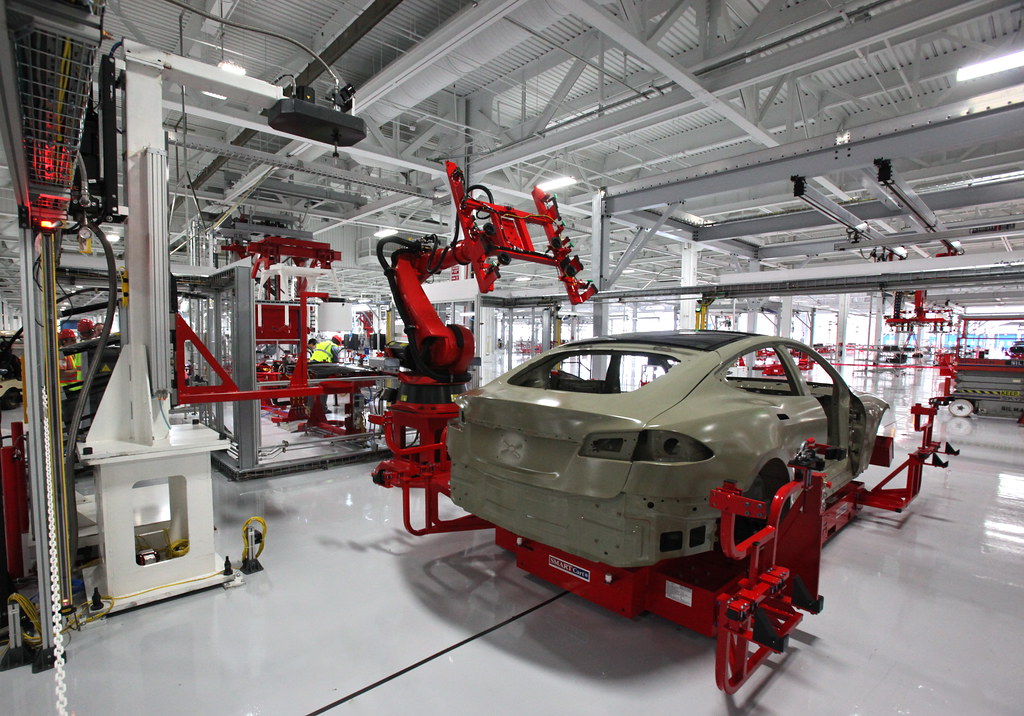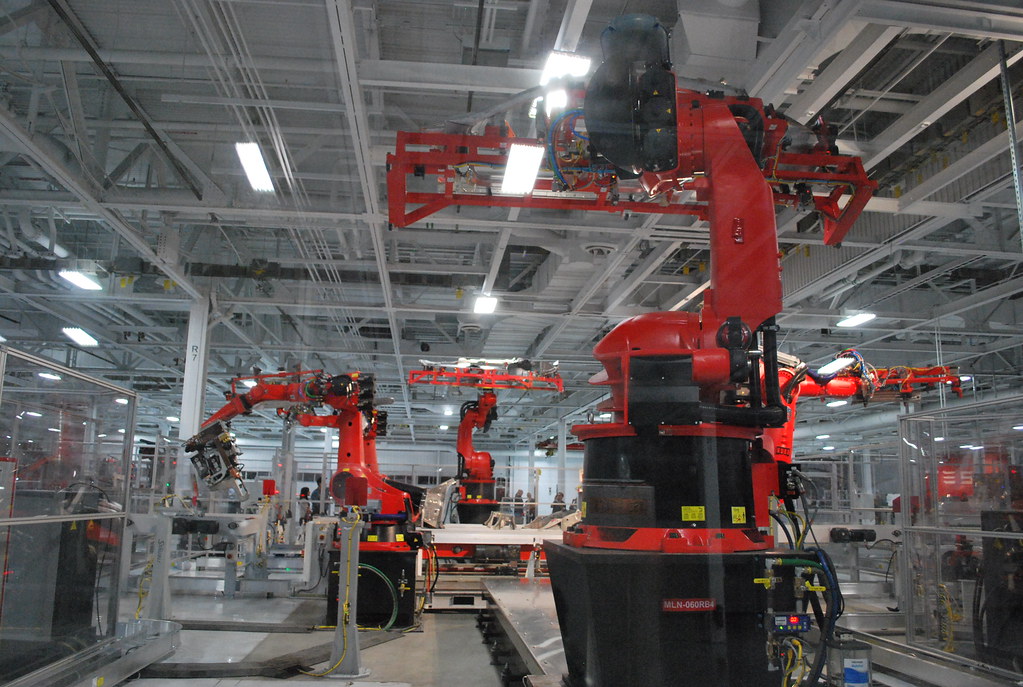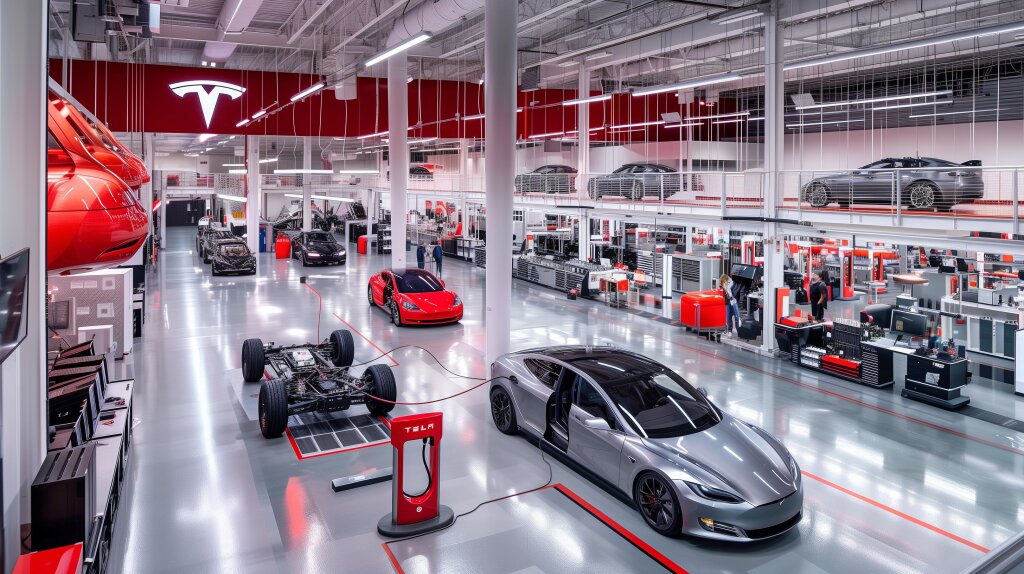Tesla has once again disrupted the automotive industry, and this time it’s not with a new car—but a new way of building them. Welcome to Tesla’s unboxed manufacturing process, a revolutionary shift in how electric vehicles (EVs) are designed and assembled. First teased at Tesla’s 2023 Investor Day, this innovation could change how the world builds cars forever.
Let’s break down what unboxed manufacturing really is, how it works, and why it matters more than you might think.
🔧 What Is Unboxed Manufacturing?
A Radical Reinvention of the Assembly Line
For over a century, automakers have followed the same basic formula laid out by Henry Ford—a long, linear assembly line where the vehicle is built from start to finish. Over time, robots and automation were added to make production faster, but the underlying system didn’t change.

Enter Tesla’s unboxed manufacturing.
Instead of a single long line, Tesla’s new method splits vehicle production into parallel, smaller lines—each responsible for building a specific part or “chunk” of the car. These chunks are then brought together at the end to form a complete vehicle.
Think of it like building with LEGO blocks, where different modules are constructed separately and then snapped together with precision.
🚀 Why Unboxed Manufacturing Is a Game-Changer
1. Efficiency Like Never Before
With each part of the car built on dedicated lines, multiple modules can be assembled simultaneously, drastically cutting production time.
2. Modularity = Flexibility
This setup allows Tesla to update or improve individual modules without disrupting the entire production line.
3. Better Vehicle Quality
Every module can be built and tested in isolation, which means higher precision, fewer defects, and better panel alignment.
🧠 The Power of Automation and AI
Tesla’s new system relies heavily on automation and artificial intelligence. And the most recent patent filings give us a first real look at how this will work—specifically, how body panels and windows will be attached.
Spoiler alert: There are no humans involved in this part of the process.
🤖 Robots + Glue + Vacuum = Perfection?
Here’s What We Know from the Patent:
Tesla’s latest patent reveals a fully automated machine that surrounds the vehicle skeleton, applying pre-painted body panels and glass with robotic precision.
Key components:
- Vacuum suction cups to hold and move panels without damaging the finish
- Industrial-strength adhesives (glue) to attach everything
- A “global datum” system to ensure perfect alignment across the entire vehicle

🧩 Why This Matters: Goodbye, Panel Gaps
Misaligned body panels are one of the most common complaints among EV owners, even in high-end models. Tesla’s robots, guided by precise reference points, aim to eliminate these issues entirely.
Instead of relying on multiple human workers installing fenders, doors, and glass, robots follow a master map, aligning everything to a global reference framework.
That means:
- Consistent panel gaps
- Perfect alignment
- A better-looking and higher-quality product
🧲 Glue? Really?
Yes, Tesla is ditching screws, welds, and clips for good old glue—but not the kind you used in school.
The Advantages of Using Glue:
- Faster assembly: Glue speeds up the process and requires fewer tools.
- Precision: Glue allows slight adjustments during installation.
- Durability: Adhesives reduce rattles, creaks, and long-term wear.
- Insulation: Better seals help block out noise and moisture.
Tesla even uses what’s referred to as an “engineered adhesive gap”—a fancy term for a thicker glue layer that fills in imperfections and ensures a flush, secure fit.
⚠️ But… What About the Cybertruck Glue Fail?
It’s worth noting that Tesla had a recent hiccup with the Cybertruck, where parts of the stainless steel trim were falling off due to glue failures.
That’s since been fixed—with stronger adhesives. Consider it a lesson learned as Tesla pushes into next-gen production.
⏱️ What About Glue Drying Time?
Waiting for glue to set could slow down the entire process. But Tesla has two clever solutions:
- Locator Pins: Hold panels in place while the glue cures.
- Hot Melt Adhesives: A temporary “hot glue” method to hold things until the real adhesive sets.
These tricks allow the line to keep moving at high speed.

📉 Fewer Fasteners, Lower Costs
According to the patent, Tesla estimates that this new system will:
- Reduce fasteners by 65%
- Cost just $25 in glue per vehicle
That’s a massive reduction in material and labor costs, making vehicles cheaper and faster to produce.
🏭 The New Factory: Giga Texas Leads the Way
Tesla’s unboxed process isn’t just theory—it’s happening right now.
At Giga Texas, Tesla has been installing new machinery and stockpiling parts for the upcoming Cyber Cab—a fully autonomous electric ride-hailing vehicle that will be the first built using the unboxed system.
Drone operator Joe Tegtmeyer, who monitors Giga Texas, has documented massive deliveries of equipment and components, signaling that production is nearly ready to begin.
🚕 Introducing: The Cyber Cab
Unfortunately, the first vehicles to use this cutting-edge process won’t be sold to the public. Tesla’s Cyber Cab will be part of their robo-taxi network, designed for fully autonomous ride-hailing.
According to Elon Musk, the unboxed assembly line will be so fast and dangerous that humans can’t even get near it—like the robotic zones in Amazon fulfillment centers.
Tesla believes the line could produce one Cyber Cab every 5 seconds, compared to the current Model Y rate of one car every 20–30 seconds. That’s a 6x speed increase.
📅 When Will We See It in Action?
Based on ongoing observations at Giga Texas, early production is likely to start in 2026. That means we could see the first unboxed Tesla vehicles rolling out next year.
And while the Cyber Cab is the first in line, this method could later be used for the next-generation $25,000 Tesla compact car, making it faster, cheaper, and more precise than ever.
🧠 Bonus: AI Is at the Heart of It All
Tesla’s innovation isn’t limited to mechanical engineering. Artificial Intelligence (AI) plays a central role in:
- Vehicle autonomy (Full Self-Driving)
- Robotics and precision assembly
- Factory operations and efficiency
And if you want to get ahead in your own career, understanding AI is now essential. Platforms like Outskll are offering free 2-day AI masterminds, where you can learn the tools that are shaping the future of every industry—from coding to content creation.
✅ Key Takeaways
Here’s why Tesla’s unboxed manufacturing is such a big deal:
- Replaces 100+ years of automotive tradition
- Cuts vehicle assembly time by over 70%
- Improves quality, alignment, and durability
- Reduces parts and costs significantly
- Enables a fully autonomous robo-taxi fleet
- Could be the key to affordable mass-market EVs

🔮 The Future of Car Manufacturing Starts Now
Tesla’s unboxed manufacturing process is more than just a clever production trick. It’s a paradigm shift that could make EVs:
- Cheaper to build
- Better in quality
- Faster to deliver
And while we may not get to drive the first unboxed Tesla (thanks to its robo-taxi exclusivity), this revolutionary assembly line is laying the groundwork for the future of transportation.
So the next time you see a perfectly aligned, quiet, and affordable electric vehicle, just remember—it was likely glued together by robots.
FAQs
1. What is Tesla’s unboxed manufacturing process?
Tesla’s unboxed manufacturing is a revolutionary new way to build electric vehicles (EVs) by assembling the car in modular chunks using parallel production lines, rather than the traditional linear assembly line.
2. Why is unboxed manufacturing important?
It drastically improves production speed, reduces costs, ensures better quality, and enables faster scaling of vehicle manufacturing—especially for future autonomous vehicles like the Cyber Cab.
3. How does Tesla’s unboxed process differ from traditional car manufacturing?
Instead of a single long production line, Tesla uses multiple smaller parallel lines to build different parts (chunks) of the car separately. These chunks are then brought together at the end to form a complete vehicle.
4. Is unboxed manufacturing faster than traditional methods?
Yes. Tesla estimates the new line could produce one Cyber Cab every 5 seconds, compared to the 20–30 seconds it takes to build a Model Y on the current line.
5. What role does AI play in Tesla’s new manufacturing method?
AI helps guide robotic systems with precision, aligns components to a global reference system, and optimizes every part of the process from panel placement to adhesive application.
6. What materials are used to attach panels and windows in unboxed manufacturing?
Tesla uses industrial-strength adhesive glue combined with vacuum suction robotics to place and secure body panels and windows—eliminating the need for screws, clips, or welds.
7. Why is Tesla using glue instead of screws or bolts?
Glue provides better alignment flexibility, fewer parts, faster application, and improved long-term durability. It also absorbs vibrations better and seals out noise and moisture more effectively.
8. Is using glue safe for cars?
Yes. Tesla uses high-performance structural adhesives similar to those used in aerospace and high-performance automotive manufacturing. When done correctly, it’s safer and more durable than traditional fasteners.
9. What is a “global datum” in Tesla’s patent?
It’s a network of reference points on the car’s frame that allows robots to align each part with perfect accuracy across the entire vehicle, reducing panel gaps and misalignment.
10. Has Tesla tested this method before?
Yes. Tesla experimented with adhesives in previous models like the Cybertruck. Although they had early failures (such as trim panels falling off), stronger adhesives have since solved the problem.
11. What are the advantages of vacuum suction robots?
Vacuum suction prevents damage to pre-painted panels by gently but securely holding them, allowing for precise placement without scratches, dents, or alignment issues.
12. What happens if the glue hasn’t dried yet?
Tesla plans to use locator pins or hot melt adhesives (temporary glue) to hold parts in place while the structural adhesive cures—ensuring the line doesn’t stop.
13. How much does the glue cost per vehicle?
According to Tesla’s patent, the total cost of adhesive per vehicle is only around $25, while reducing the number of fasteners by about 65%.
14. Where will Tesla first use the unboxed manufacturing process?
Tesla’s Giga Texas factory will be the first to implement the unboxed line, starting with the Cyber Cab, Tesla’s upcoming autonomous ride-hailing vehicle.
15. Can customers buy a car made with the unboxed process?
Not yet. The first vehicles made with the unboxed system will be Cyber Cabs, which are part of Tesla’s robo-taxi fleet and not for sale to individual consumers.
16. When will unboxed manufacturing go into production?
Early signs indicate that production could start in early 2026, based on equipment deliveries and preparations observed at Tesla’s Giga Texas facility.
17. Will Tesla use unboxed manufacturing for other vehicles in the future?
Most likely, yes. Tesla is expected to expand this process to future models, including the rumored $25,000 compact EV, to scale production while reducing costs.
Read More:
- Something Unusual is Happening with SpaceX Starship V3 Progress! What is Holding Up
- Tesla reveals some crazy Supercharging (and Diner) stats from Q3
- Tesla Model Y Performance has a killer feature beyond its speed
- Elon Musk is halfway towards becoming the world’s first trillionaire
- Tesla hits record vehicle deliveries and energy deployments in Q3 2025

